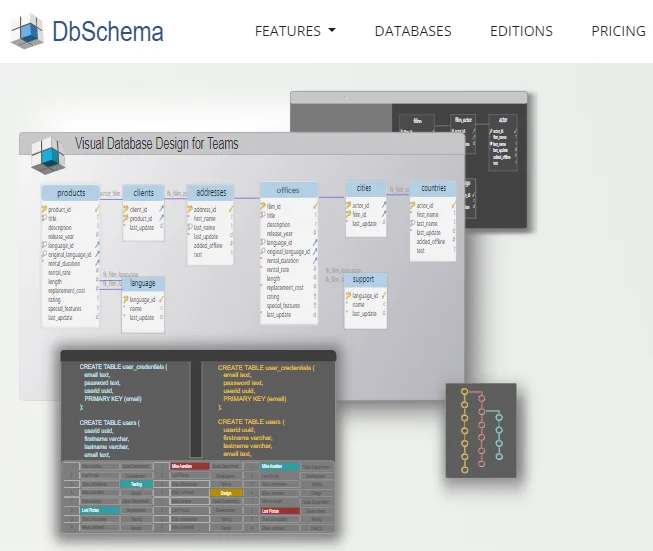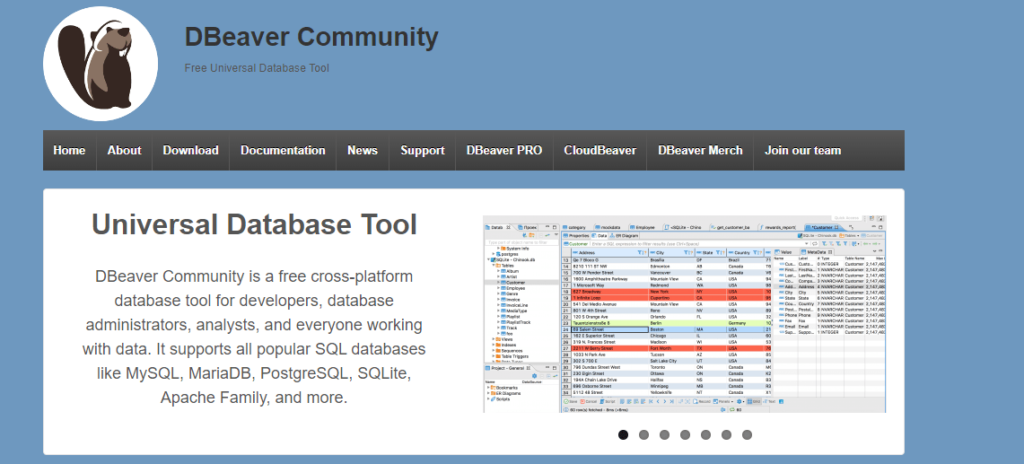Well-structured databases are crucial for effective data management. Choosing the right design tool can streamline database modeling, simplify administration, and maintain data integrity. This guide presents the top 10 free database design tools, each offering unique features to cater to various needs. From visual schema designers and multi-database managers to tools specifically optimized for certain database systems, whether you are a seasoned database professional or new to database design, these tools can help you efficiently design and manage scalable databases.
Top 10 Free Database Design Tools for 2025
- DbSchema (Community Edition)
- MySQL Workbench (Community Edition)
- DBeaver (Community Edition)
- pgAdmin
- DbVisualizer (Free Edition)
- HeidiSQL
- Oracle SQL Developer (Free)
- SQL Power Architect
- QuickDBD
- dbdiagram.io
1. DbSchema (Community Edition)
DbSchema Community Edition is a visual database design tool that supports offline modeling and seamless database synchronization. It emphasizes diagram-based schema design, making it easier to understand and communicate complex structures.

Key Features:
- Visual Schema Designer (ER diagrams)
- SQL Editor with syntax highlighting
- Automated diagram generation
- Offline design and later database synchronization
- HTML documentation generation
- In-tool data editing and basic query building
Ideal For: Teams or individuals who want a user-friendly visual schema environment, offline design capabilities, and straightforward documentation generation.
2. MySQL Workbench (Community Edition)
MySQL Workbench is Oracle’s official, free interface for MySQL, offering an end-to-end solution from database design to administration and performance monitoring.

Key Features:
- Visual database modeling tools
- SQL development with auto-completion and debugging
- Reverse and forward engineering of schemas
- Server configuration and user administration
- Data migration utilities
- Performance dashboards and metrics
Ideal For: MySQL-based environments that need a comprehensive, integrated tool for modeling, query development, and routine database administration.
3. DBeaver (Community Edition)
DBeaver is a multi-database management tool that supports a wide range of databases. It provides ER diagramming, SQL editing, and performance monitoring in a single, cross-platform package.

Key Features:
- Broad database compatibility (MySQL, PostgreSQL, Oracle, SQL Server, etc.)
- Advanced SQL editor with syntax highlighting
- ER diagramming for schema visualization
- Performance monitoring and optimization tools
- User and role management
- Backup and restore utilities
Ideal For: Database professionals and developers managing multiple databases who need a unified interface for design, administration, and performance analysis.
4. pgAdmin
pgAdmin is the go-to open-source administration and design tool for PostgreSQL, offering a range of features tailored to this popular open-source database system.

Key Features:
- Comprehensive PostgreSQL server and database management
- Advanced SQL editor with syntax highlighting
- ER diagramming for schema visualization
- Performance monitoring tools
- User, role, and permission management
- Backup and restore functionality
Ideal For: PostgreSQL administrators and developers looking for a dedicated, feature-rich tool specifically optimized for the PostgreSQL ecosystem.
5. DbVisualizer (Free Edition)
DbVisualizer is a universal database tool that provides a simplified interface for SQL execution, schema exploration, and data transfer, supporting numerous databases.

Key Features:
- SQL editor with syntax highlighting
- Browser for tables, views, and other database objects
- Supports various databases (MySQL, PostgreSQL, SQL Server, etc.)
- Data export and import capabilities
- User management tools
- Customizable UI with a clean, intuitive interface
Ideal For: Users who want a straightforward, cross-platform database tool for basic design, queries, and data handling without a steep learning curve.
6. HeidiSQL
HeidiSQL is a lightweight yet powerful Windows-based database client that connects to multiple database systems. It focuses on ease of use and efficient data management.

Key Features:
- Multi-database compatibility (MySQL, MariaDB, SQL Server, PostgreSQL, etc.)
- Multiple session management in a single window
- Data editing within tables
- Table, view, and routine management
- Export/import utilities and SSH tunneling
- Customizable interface and data visualization tools
Ideal For: Developers seeking a user-friendly, multi-database client for Windows who need efficient data editing and management in a compact interface.
7. Oracle SQL Developer (Free)
Oracle SQL Developer is Oracle’s official tool for Oracle Database administration, development, and design. It simplifies PL/SQL development and database migration tasks.

Key Features:
- Oracle Database-focused IDE with PL/SQL debugging
- Entity-Relationship Diagram (ERD) generation
- SQL worksheet with code insight and history
- User and role administration, performance tuning
- Data import/export in various formats
- RESTful services development and migration utilities
Ideal For: Oracle Database professionals who need a comprehensive tool to handle design, development, and administrative tasks within the Oracle ecosystem.
8. SQL Power Architect
SQL Power Architect is a data modeling and profiling tool that allows for effective visualization, design, and reverse engineering of database structures.

Key Features:
- ER diagramming and logical/physical modeling
- Reverse engineering from existing databases
- Data profiling for quality and schema refinement
- Cross-platform compatibility (Windows, macOS, Linux)
Ideal For: Data architects and modelers who need a tool focused on conceptual and logical design, reverse engineering, and data quality assessment.
9. QuickDBD
QuickDBD transforms simple text input into structured database diagrams, facilitating rapid sketching and sharing of database structures.

Key Features:
- Text-to-diagram conversion for fast modeling
- Export diagrams as images, PDFs, or SQL scripts
- Collaboration through shareable links
Ideal For: Teams and individuals who need a quick, no-frills way to turn brainstorming or notes into visual ER diagrams and share them instantly.
10. dbdiagram.io
dbdiagram.io uses a domain-specific language (DSL) to swiftly generate ER diagrams, making it easy to define schemas as code and visualize them in real-time.

Key Features:
- DSL-based diagram creation
- Import SQL scripts and export diagrams in various formats
- Online collaboration and sharing
Ideal For: Remote or agile teams that need a fast, code-centric approach to creating and iterating on database diagrams, while enabling seamless online collaboration.
Conclusion
The best database design tool depends on your specific environment, database technologies, and workflow. The tools listed above cover a broad spectrum—from single-database specialists like pgAdmin to multi-database managers like DBeaver and from visual diagramming solutions like DbSchema to text-based approaches like QuickDBD.